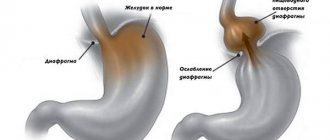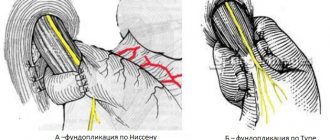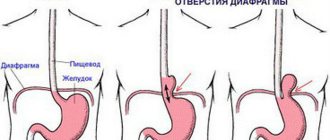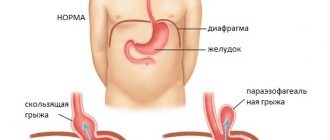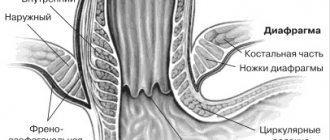Cardia insufficiency is a disruption of the activity of nerve trunks and, accordingly, the contractility of the muscular sphincter at the border of the lower part of the esophagus and the upper part of the stomach. Typically, these functional disorders are combined with changes in the mucous membrane of the esophagus, as a constant reflux of the acidic contents of the stomach develops into the cavity of the esophagus, where the environment is alkaline. The severity of the clinical symptom complex is determined by the stage of the disease.
What is cardia?
The digestive tract contains circular muscles that act like valves. They help food move through the esophagus, stomach and intestines. Such muscles are called sphincters, they are able to contract when necessary and close the passage. The cardia of the stomach is one of these muscles. It is located between the stomach and esophagus and regulates the flow of food. The sphincter is closed when a person is not eating and opens when eating so that food can enter the stomach. This happens during normal muscle functioning. The cardia prevents food and gastric juice from flowing back into the esophagus.
But sometimes the sphincter malfunctions, and then gastroenterologists diagnose “cardia insufficiency.” What it is? The pathology is that the muscle stops contracting or does not close completely, and food, along with gastric juice, is thrown into the esophagus. In medicine this is called reflux. This phenomenon can also occur in completely healthy people. But during normal functioning of the body, the esophagus is protected, the mucous membrane is quickly restored, and inflammation does not occur.
But if the protection of the esophagus is reduced, then the reflux of acid and food leads to burns and inflammation of the mucous membrane. This disease is called reflux esophagitis, and it requires immediate treatment. In advanced cases, ulcerations appear on the lower part of the esophagus. Externally, the cardia resembles a round rosette. In a healthy body it closes in a circle. With its pathology, gastroenterologists talk about insufficiency of the cardia rosette.
Classification
The classification of cardia cancer is based on the location of the center of the tumor. The anatomical reference point is the Z-line - the line of the esophagogastric junction.
- Type I cancer - the center of the tumor is located at a distance of 1-5 cm above the Z-line towards the esophagus.
- Type II cancer - the center of the tumor is located within 1 cm orally and 2 cm below the Z-line.
- Type III cancer - the center of the tumor is located at a distance of 2-5 cm below the Z-line.
Etiology
In most cases, cardia failure occurs against the background of functional disorders. Less commonly, the cause is organic abnormalities.
Table 1. Causes of cardia failure
| Nature of the disorder | Description |
| Functional | Sphincter spasm leads to an increase in intra-abdominal pressure, which is fraught with increased gas formation and fermentation. |
| Organic | The disease occurs against the background of a hernia. The lower sphincter is displaced into the chest, which leads to smoothing of the esophagogastric angle and loose closure of the valve. Chronic pancreatitis can also provoke cardial insufficiency. |
This disease can also appear for more “prosaic” reasons:
- eating disorder;
- obesity;
- decreased immunity;
- eating a lot of food before bedtime;
- sedentary lifestyle;
- excessive physical activity.
Tumors of the stomach, ulcers, gastritis and abdominal surgery are also at risk.
Reasons for development
Doctors identify several provoking factors for this disease.
- An improperly planned diet, especially overeating, significantly increases the likelihood of pathology.
- Being overweight also increases your risk of developing the disease.
- Various diseases of the gastrointestinal tract, especially ulcers and inflammation of the esophageal mucosa.
- Spasmodic attacks of the pylorus.
- Little physical activity weakens the muscle system, which increases the risk of disease.
- Constantly increased level of pressure in the abdominal area, explained by the process of bearing a child or ascites.
- Increased pressure inside the stomach.
- Surgical interventions to remove the sphincter.
- Excessive physical activity also leads to disturbances in the functioning of the cardia.
The disease develops as a result of the inability of the sphincter to retain acidic substances in the stomach. Food enters the stomach at low pressure, a few millimeters of mercury is enough. Reverse movement requires a load ten times greater. For this reason, with an increased degree of gas formation, reflux of stomach contents into the esophagus is possible, accompanied by characteristic clinical signs.
Doctors believe that the main mechanism for the progression of pathology is problems in the functioning of smooth muscle tissue located in the area of the diaphragm. The syndrome is characteristic of a chronic inflammatory process of the pancreas, with gastritis. The risks of pathology also increase with a diaphragmatic hernia.
In a healthy person, the sphincter is completely closed, except when eating. The cardia also blocks the return of contents into the stomach.
The sphincter must work without disturbances and ensure the proper functioning of the gastrointestinal tract. Otherwise, the mucous membrane of the esophagus is not able to regenerate, as a result, a person’s risk of developing gastrointestinal pathologies, for example, pancreatitis or gastritis, increases.
Doctors highlight a list of diseases that increase the likelihood of developing sphincter dysfunction.
- In the case of an anatomical anomaly, which is a hole in the diaphragm. The upper section of the gastrointestinal tract connects to the chest cavity, which in some cases provokes the development of the disease described above.
- Asthmatic disease and diabetes mellitus can also lead to the development of dysfunction of the cardia.
- Syndrome of loss of strength, called adynamia in medical practice.
- Various chronic diseases of the gastrointestinal tract, for example, ulcerative formation of the duodenum.
- Connective tissue pathologies (scleroderma).
General symptoms of cardia failure
Cardia insufficiency at any stage of its manifestation is characterized by certain symptoms. With their help, you can timely detect the disease at the first stage of development:
- nausea;
- dizziness and weakness accompanying any activity of the patient;
- constant heartburn that occurs regardless of the meal schedule;
- vomit;
- pain in the epigastric region;
- belching air;
- rumbling in the intestines.
As the disease progresses, these symptoms will intensify.
Cardiac insufficiency: stages of the disease
Cardia insufficiency occurs in the human body through 3 stages.
Table 2. Stages of the disease
| Stage | Description | Symptoms |
| I | Partial valve closure. The opened space occupies up to 1/3 of the diameter of the esophagus. | Frequently repeated belching of air. |
| II | The sphincter closes only 50%. Such a large gap risks the folds of the esophagus getting into the stomach. | Belching, discomfort in the central part of the peritoneum and prolapse of the mucous membrane. |
| III | Full opening of the sphincter. Despite the fact that the motility of the esophageal tube is preserved, an inflammatory process begins on its walls with the formation of erosions and ulcers. | Severe heartburn, epigastric discomfort, pain while eating, nausea and vomiting. Sometimes there is an increase in body temperature. |
The first degree of cardia insufficiency is mild. If belching occurs, you should immediately consult a specialist doctor.
Possible complications
Most people do not notice changes in the body as the pathology progresses. However, lack of timely treatment will lead to serious complications. These include the formation of ulcerative lesions in the gastrointestinal tract, inflammation of the mucous membrane of the esophagus, stricture of the esophagus, possible discomfort during swallowing, as well as prolapse of the digestive tract.
Once an acidic substance enters the throat, there is a possibility of developing problems with the respiratory system. Long-term development of cardia failure significantly increases the risk of cancer cells in the esophagus. Over time, Barrett's syndrome develops, characterized by the appearance of tissue-like formations in the body. Also, disorders in the functionality of the sphincter increase the likelihood of developing a malignant tumor of the esophagus - adenocarcinoma.
Diagnosis of the disease
Due to mild symptoms, determining the stage of chalazia by external signs is quite problematic. The most effective way is endoscopic examination.
Endoscopy is a technique that is widely used to diagnose diseases of the gastrointestinal tract. An endoscope is a device consisting of a probe equipped with a camera and a monitor showing an image of the internal organs.
In addition to endoscopy, FGDS, ultrasound diagnostics, radiography with the use of a contrast agent and pH-metry are prescribed to make an accurate diagnosis. A comprehensive examination allows the gastroenterologist to adequately assess the condition of the esophageal mucosa, determine the degree of cardia insufficiency and identify concomitant pathologies.
Treatment
First of all, it is important to direct efforts to eliminate the disease that provoked cardia failure. For example, if a patient is overweight, you need to adjust your diet and adhere to a therapeutic diet. After this, it is necessary to reduce the pressure in the peritoneum. This measure is especially relevant in the development of ascites.
Treatment of the disease is carried out in several areas:
- taking medications. The doctor prescribes antacids, antispasmodics and agents that coat the mucous membranes;
- diet therapy. An individual diet is selected, based on the exclusion of fried, spicy, salty foods, smoked foods, lard, fatty dairy and meat products, coffee and alcoholic beverages;
- use of folk remedies. Seeking help from the gifts of nature is possible only after consultation with your doctor;
- surgical intervention. In the event of a hernia formation that contributes to the development of chalazia, a tissue suturing procedure is performed.
To prevent a surgical method of combating the disease, it is necessary to recognize cardia failure at stage 1.
Prognosis and prevention
The 5-year survival rate for any type of CER averages 23.6%. Type III tumors have the most unfavorable course, since they are predominantly represented by poorly or undifferentiated neoplasms. The 5-year survival rate for this location is about 14%. The prognosis is significantly worsened by the presence of metastases in the mediastinal lymph nodes.
Euroonko employs doctors with extensive experience in treating stomach cancer. We are guided by current European standards. For this, the clinic has everything necessary - from the latest medications to modern equipment, thanks to which we are ready to provide assistance in the most severe cases.
Book a consultation 24 hours a day
+7+7+78
Traditional medicine
Pharmacists have in their arsenal a large number of drugs aimed at treating chalazia. Depending on the stage of the disease, appropriate medications are prescribed.
Table 1. The most common drugs
| A drug | Description |
| The action of the emulsion is based on inhibition of gastric juice production. Thanks to this, the content of hydrochloric acid in it is reduced to the required limit. Has an anesthetic effect. Due to the fact that it is a choleretic drug, a slight laxative effect is possible. | |
| Naturally based adsorbent. Stabilizes the microflora of mucous membranes and increases the gastroprotective functions of mucus. | |
| Antiemetic drug. Relieves hiccups, normalizes the activity of the gastrointestinal tract and enhances peristalsis. Promotes healing of ulcers. | |
| In addition to the antiemetic effect, the drug stimulates the muscle tone of the gastrointestinal tract. Normalizes the activity of the gastrointestinal tract and reduces the motor activity of the esophagus. Increases the tone of the lower valve of the esophagus, improves bowel movements without causing diarrhea. |
You should take medications only as prescribed by your doctor. In addition to taking medications, it is important to lead a healthy lifestyle and adhere to a diet.
Dietary recommendations
Proper and healthy nutrition for gastric sphincter insufficiency is the basis of the entire therapeutic approach. In order to quickly recover and prevent exacerbations of the disease, you should:
- Avoid consuming foods that can cause a decrease in tone. These include: chocolate products, carbonated drinks, pepper, tea, coffee, seasoned foods.
- Avoid spicy and fatty foods.
- Completely eliminate the consumption of alcohol and tobacco products.
- Meat protein, on the contrary, helps to increase the tone of the LES and reduce symptoms.
The main condition for the complete absorption of food is its frequent consumption in small portions. A minimum 4-hour interval should be observed between main meals. At the end of the meal, refuse to take a lying position, and preferably sleep with the head end raised.
When diagnosing cardia insufficiency, it is recommended to consult a nutritionist to create the right diet. Adjusting your diet will significantly speed up the healing process.
| Measure | Description |
| Diet | The state of the gastrointestinal tract largely depends on the diet. Fasting is strictly contraindicated. The last time of the day you need to eat 3-4 hours before your expected bedtime. You should also avoid foods that negatively affect the esophagus. These include smoked and spicy dishes |
| Eliminating obesity | Avoid weight gain, respond promptly to negative changes in weight and take appropriate measures to correct the situation. Excess weight negatively affects the condition of the entire body. |
| Workout | Physical activity without overexertion is a prerequisite for maintaining a healthy state of the gastrointestinal tract. |
| Doctor visits | If clinical signs of gastrointestinal diseases occur, promptly contact a medical institution for advice and undergo diagnostic procedures |
| Bad habits | Drinking alcoholic beverages, smoking, and taking narcotic drugs negatively affects the functioning of not only the gastrointestinal tract, but also the entire body. |
| Overvoltage | Excessive physical activity should be avoided |
| Self-treatment | If clinical signs of the disease occur, you should not take medications to relieve symptoms. Independent use of antibacterial and other agents is also not recommended. There is a high risk of aggravating the course of the disease. Doctors recommend that if the first signs of cardia insufficiency occur, you should contact a medical facility. |
Diet for cardia deficiency
An important component of treatment is maintaining proper nutrition. In order for the functional failure of the cardia to stop developing, you will have to refuse:
- spices;
- spices;
- fried;
- fat;
- canned food;
- smoked products;
- sour berries and fruits;
- pickles and marinated dishes;
- ketchup;
- muffins;
- fresh bread;
- stewed meat and fish;
- kvass;
- Luke;
- radishes;
- radish;
- legumes;
- pasta;
- rice;
- mayonnaise;
- hard-to-digest porridges;
- chocolate;
- alcohol;
- sour juices.
The list of permitted products looks like this:
- low-fat soups;
- beef;
- chicken;
- turkey;
- meat and poultry dishes, steamed or oven-cooked;
- crackers;
- wheat bread;
- dishes from lean fish;
- cereals with low fiber content;
- low fiber vegetables;
- omelette;
- puree;
- compotes;
- fruit jelly;
- jelly;
- weak tea;
- honey;
- sugar in small quantities.
Folk remedies for pathology
To tone the cardiac sphincter, drinks containing caffeine are completely excluded from the diet. However, herbal infusions from medicinal plants valerian and St. John's wort are an alternative. Traditional medicine therapy is relevant only in the initial stages of the disease, when there are no complications, or during remission. In the morning on an empty stomach, as well as before each meal, it is recommended to drink a glass of warm water.
In order to achieve a therapeutic effect, it is useful to use the following recommendations:
- Plantain juice helps normalize digestion.
- Between main meals, it is useful to drink an infusion made from calamus root. To do this, 5 grams of raw materials are poured into a glass of boiling water.
- Three times during the day, drink a medicinal infusion for the stomach, which is prepared from peppermint, plantain, St. John's wort, chamomile and yarrow.
- Dandelion flowers, which are covered with sugar and ground and then decanted, have a high therapeutic effect. The resulting syrup is diluted with water.
Cumin is an indispensable remedy for restoring and maintaining proper functioning of the stomach. It can be consumed as a decoction or crushed and added to breakfast cereals.
Help from therapeutic exercises
The muscular structures of the gastric cardia can be easily strengthened. For this purpose, specially designed breathing exercises are used. Particularly popular is Strelnikova’s gymnastic method, which involves performing training twice during the day: in the morning and in the evening before a meal, and also after an hour and a half after its end, for 1500 breaths. As a preventive measure, gymnastics is performed in the morning or evening period. Such breathing exercises help strengthen the body and improve the health of internal organs due to increased blood flow.
